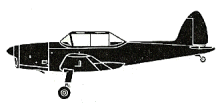
ASN Wikibase Occurrence # 139866
This information is added by users of ASN. Neither ASN nor the Flight Safety Foundation are responsible for the completeness or correctness of this information.
If you feel this information is incomplete or incorrect, you can submit corrected information.
| Date: | Saturday 2 February 1963 |
| Time: | |
| Type: |  de Havilland Canada DHC-1 Chipmunk T.10 |
| Owner/operator: | Aviation Services (South Australia) Ltd |
| Registration: | VH-BSP |
| MSN: | C1/0063 |
| Fatalities: | Fatalities: 0 / Occupants: 1 |
| Aircraft damage: | Destroyed |
| Location: | 9 miles S of Turnby Bay, SA -
 Australia Australia
|
| Phase: | En route |
| Nature: | Private |
| Departure airport: | Whylla, South Australia |
| Confidence Rating: |
Ex-RAF Chipmunk T.10 WB622; struck off charge/sold 25/06/1956 to Tasmania, Australia.
Aviation Services (SA) Ltd ran flying schools in South Australian country towns with a modest fleet of Chipmunks. VH-BSP, which had been acquired from the Tasmanian Aero Club at Launceston, was based at Whylla.
On 2 February 1963 VH-BSP was flown into the ground - allegedly deliberately - some 9 miles south of Turnby Bay, South Australia by its 20 year pilot, Miss R. Puckridge. The Department of Civil Aviation report stated that it was a "probable suicide gesture".
Local gossip at the time conjectured that Miss Puckridge was distraught over the death of the pilot of Chipmunk VH-UEK which had crashed in the same general locality a week or so earlier, while low flying. It was rumoured that she had a romantic relationship with this pilot.
In the event, the gesture was futile, insofar as the undercarriage of VH-BSP bore the brunt of the impact, and Miss Puckridge sustained only minor injuries. However, these two crashes within two weeks of each other were probably the reason that caused Aviation Services to abandon their cross-country flying training operations, and leave it to the Royal Aero Club of South Australia, who had, for years, received criticism for not providing training outside Adelaide.
This was rectified when the club purchased a large fleet of Victa Airtourers and began providing regional training. Meanwhile Aviation Services concentrated on Auster maintenance at Parafield and became agencies for Beagle and a other types.
The fin, rudder and tailplane of VH-BSP (along with several other Chipmunk bits and pieces) are now to be found at the Queensland Air Museum, which is rebuilding a Chipmunk from the remains of several airframes. The restored airframe will carry the markings VH-RVV
Sources:
http://www.edcoatescollection.com/ac1/austb/VH-BSP.html
http://www.facebook.com/media/set/?set=a.133263966721967.24044.131781546870209&type=1
www.ukserials.com/results.php?serial=WB
Revision history:
| Date/time | Contributor | Updates |
|---|---|---|
| 13-Nov-2011 08:53 | Dr. John Smith | Added |
| 09-Jun-2022 23:02 | Ron Averes | Updated [Location, Narrative] |
Corrections or additions? ... Edit this accident description
The Aviation Safety Network is an exclusive service provided by:


 ©2024 Flight Safety Foundation
©2024 Flight Safety Foundation